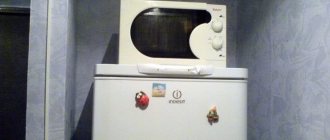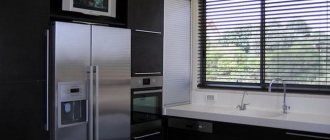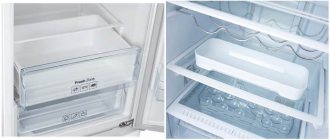The usable area of kitchens in old houses or modern small families often does not exceed 5-6 sq.m. Therefore, when purchasing household appliances, many people have doubts about their correct placement. Advice from experts will help you figure out how to place a refrigerator next to a heating radiator: is it possible or not, what should be the distance to heating devices, how to avoid overheating and damage to an expensive device.
Basic moments
Before purchasing a refrigerator, you should consider delivery issues - hire a vehicle of the appropriate size, measure the elevator doors, entrance and kitchen door openings so that the unit can be brought into the room without any problems. If you transport the device by placing it on the door or back wall, the compressor may come off and the freon may not flow properly, which can cause an air bubble to form and the system’s tightness may be compromised.
In winter, the distance of the device to the wall should be about 5 cm.
The most important installation rules:
- you need to place the refrigerator away from the sun and drafts, but where there is sufficient movement of air masses;
- in winter, the distance from the wall to the back wall of the unit is about five centimeters, in the summer it is moved back another three to five;
- the further the refrigerator is placed from any heating devices, the better, but it is not advisable to place it exactly opposite a gas, electric stove, heating radiator, etc.;
- Items such as a washing machine, any other electrical appliances (coffee maker, microwave oven, toaster, etc.) must not be installed in close proximity to the item;
- the refrigerating cabinet is placed at the same distance from various pieces of kitchen furniture;
- You should not connect the refrigerator through an extension cord or tee - it is permissible only through a stationary outlet.
Other household appliances are not allowed to be installed close to the refrigerator.
Instructions for installing heating radiators
So, how to hang radiators correctly? You have purchased radiators and even decided exactly how they will be installed. Now you need to familiarize yourself with all the requirements of SNIP - and you can begin installation. It's actually quite simple.
And they really need to be followed - after all, if the radiator is installed incorrectly, if it breaks, repairs under warranty will be denied.
Heating radiator installation diagram
If you want to protect the device from scratches, dust and other damage that may occur during installation, then during the installation process you can not remove the protective film - this is allowed by the rules for installing radiators. The single most important requirement that must be strictly followed is strict adherence to the indentations necessary for normal circulation of heated air. Here are the rules for installing heating radiators to indentations put forward by SNIP:
- According to current standards, the distance from the window sill or the bottom of the niche should be at least 10 cm. It should be taken into account that if the gap between the radiator and the wall is less than ¾ of the depth of the radiator, the flow of warm air into the room will be much worse.
- Equally strict requirements are imposed on the installation height of radiators. How to properly place heating batteries? So, if the distance between the bottom point of the radiator and the floor level is less than 10 cm, then the outflow of warm air will be difficult - and this will negatively affect the degree of heating of the room. The ideal distance is 12 cm between the floor and the radiator. And if this gap is more than 15 cm, then there will be too large a temperature difference between the upper and lower parts of the room.
- if the radiator is installed not in a niche under the window, but near the wall, then the distance between the surfaces should be at least 20 cm. If it is smaller, air circulation will be difficult, and in addition, dust will accumulate on the back wall of the radiator.
Installing heating radiators against the wall
In order to get maximum useful information regarding the installation of radiators, you can use our resource. You can find many valuable tips and recommendations on how to properly install a heating radiator.
Consequences of placing a refrigerator near a radiator
For normal operation of the unit, an influx of cold air is necessary, which the battery will be deprived of. Therefore, in order to maintain the set temperature in the chambers, he will have to work almost non-stop. This will make the electric meter spin faster and the refrigerator compressor wear out faster. It is likely that when the heating season ends, you will have to buy a new unit.
This type of installation of a refrigerator is understandable if the owner wants to get rid of an annoying thing as quickly as possible, but it’s a pity to throw away a working unit.
If you place the refrigerator next to the radiator, sideways, then in this case, too, due to the warm air, ice will quickly form in the freezer. The freezer will have to be cleaned more often, and greens frozen in the refrigerator compartment will lose their smell and taste. Still, this is better than installing equipment with a compressor close to a hot battery.
Since some or all of the heating radiators will be closed, the room will become cooler, as the heat will go to heat the refrigerator and will be dissipated above. Having decided to place the refrigerator next to the battery, you should know that after this you will be denied warranty repairs because the conditions specified in the instructions have been violated.
We recommend: How often should you change the carbon filter in your kitchen hood?
3
Correct placement in the kitchen
The service life of the refrigerator compartment depends not only on its location in relation to the heating system, but also on other devices that emit heat.
The situation when the refrigerator is installed directly next to the stove is even more dangerous.
This is due to the fact that the stove operates constantly and emits a very high temperature compared to radiators, which are in a warm state only for a few months a year. If the refrigerator is located near the stove, then one side of it will always be hot, and the other will be cold. The food inside will freeze and store unevenly.
It is highly undesirable to install a refrigerator near a window on the south side of the apartment. The hot rays of the sun will constantly affect the device, contributing to its failure. The effect of the rays will be enhanced by the window glass. Constant overheating means that the device will spend a lot of energy maintaining the desired temperature. Continuous loads will cause the refrigerator motor to break down.
To ensure stable and uninterrupted operation of the device, it needs constant air circulation. You must ensure that the distance between the device and other appliances is no less than 5 cm. If the kitchen area does not allow such gaps, then you should try not to install the appliances very close to each other.
For this purpose, the legs of the refrigerator must be raised to the maximum possible height.
Using the legs, you can adjust the position of the refrigerator, since the floor in the room may not always be level. This will help prevent the door from opening on its own and prevent damage to the cooling system.
We recommend
Why can't you put hot food in the refrigerator?
Alternative options
If there is no suitable space in the kitchen, you can choose an alternative installation option to extend the life of the technical device and free up space.
The list includes the following options:
- Placing the device in the pantry will save space in the kitchen. There is no air overheating in this room, because supplies and things are stored. The shelf life of the refrigeration unit can be extended. There should be an electrical outlet in the pantry or next to this room.
- A glazed loggia or balcony is a comfortable option for installing a refrigerator. The most convenient loggia is the one adjacent to the kitchen. However, it is important to consider that the room must be heated.
- In small apartments, you can move the household unit into a spacious corridor or hallway. You can allocate space in the closet for a compact refrigerator. The advantage is the close location of the kitchen, stable low air temperature.
- In some cases, it is recommended to place the device in the dining area; there is good air circulation in the room; the equipment will work for a long time.
Is it possible to place a refrigerator next to the radiator?
The distance from the refrigerator to the radiator is only one of the parameters that must be taken into account in determining the correct location for installing the refrigeration unit
Now this problem has become very urgent, because the variety of manufactured models provides for various precautions
It is important to consider the following factors:
- The correct location of a household electrical appliance is not only about taking into account possible damage from heat sources (oven, microwave, gas or electric stove, radiator). For different models, it matters how to place the refrigerator in relation to the ceiling, walls and floor, sunlight, air flows circulating in the room for cooking food.
- Any household unit should not be located close to heat sources. Otherwise, the load on the compressor, designed to provide the opposite phenomenon - the production of cold, will increase, and it will work in increased mode. This will entail increased energy consumption. An imbalance is also possible, which is ensured by the efforts of designers who locate the cooling system in the right places with the expectation of maximum efficient production. Compressor failure will trigger the need for repairs. And if incorrect operation is discovered, then the service center employees have the right to refuse to provide free service.
- Damaging factors in the kitchen, especially a small one, are present in all their diversity. These are grease and splashes from a nearby stove, infrared radiation from a microwave, ultraviolet radiation and drafts from a window or balcony. Plus condensation from vapors, the safest of which can be considered steam from simple boiling water. Dimensions are an important aspect not only when studying hypothetically free space. Sometimes the purchased giant does not fit through doorways or covers half of the window, preventing large pots and pans with handles from being placed on the stove.
Nuances of remoteness
Without thinking whether it is possible to place a refrigerator next to a pipe or radiator and devices for distributing heat, a person places the refrigerator next to them. They may not always heat enough, but they work constantly during the heating season.
Failure to maintain the minimum distance from the rear or side wall will result in poor air circulation along the cooling system location. If we add to this the unit’s system, which in its most advanced design can withstand +43 °C, hot summer time and cooking, you can say goodbye to the desired refrigerator, for which you have been saving money for a long time.
And the last little secret - if the unit is standing at the wrong angle, its door opens with difficulty and does not slam shut spontaneously at the right time, and the open door interferes with movement around a small room - it means that the choice of place is wrong, even if all the previous conditions are met. Warm air will constantly flow into the slightly open refrigerator door, and this is a sure way to damage it, and in a short time.
Before you buy the coveted symbol of kitchen luxury, you need to choose a place where you can put it. There are no hopeless situations, and craftsmen or installers can easily solve the problem with the help of protective devices, sometimes very expensive ones. Are the efforts and resources worth the opportunity to squeeze a refrigerator next to a gas stove or radiator? You need to think carefully. Sometimes it is cheaper to simply purchase a smaller device.
How to extend the life of equipment
The question may arise: where should you put the refrigerator to extend its life? You need to think about this at the renovation stage. After all, moving it in the future will be problematic. It is necessary to prepare the outlet in advance and arrange the furniture accordingly.
You cannot place the refrigerator not only next to the radiator, but also near any heat sources. Including near the stove - it doesn’t matter whether it’s gas or electric. After all, when using it, the unit will also not be able to operate in normal mode. And if the heating, depending on the region, works from a couple of months to six months, or even more, then the stove is used daily throughout the year.
If the kitchen has a loggia, then it can be attached to the main room and the refrigerator can be placed there.
Also, you should not place the unit near a window, especially if the kitchen is on the sunny side. The sun heats its surface, so the motor works intensely most of the time. But if there is no other convenient place, then you need to hang very thick curtains that do not let in the sun's rays.
It is also important to ensure normal air circulation for the refrigerator. You need to know at what distance from the furniture it is advisable to place the equipment: it should be at least 5 cm. If this is not possible, at least a small gap should be left. In such cases, it is recommended to raise the unit higher above the floor surface by adjusting the legs accordingly. This measure will make it possible to compensate for small gaps on the sides.
Ideas for placing a refrigerator
Even in a small kitchen, it will be possible to place the refrigerator so that it does not stand near the radiator. For example, you can choose a unit of a non-standard size. Narrow and tall will allow you to store a sufficient amount of food, and will take up less space. Another option is a built-in refrigerator. The height of this equipment allows you to install shelves on top for storing kitchen utensils. There are also very small models that are installed under the work surface. They usually do not have a freezer, but it can be placed separately, also under the countertop. True, such a compact unit is suitable only for a very small family.
The refrigerator can be removed from the room and placed in another room. Often a corridor is used for this. But this is not very practical, because this unit is quite loud. If you place it in the corridor, the noise will be clearly audible in the rooms. In addition, bulky equipment is likely to block the passage, and moving around will become problematic.
The best option is a pantry, especially if it is located next to the kitchen. But since the refrigerator is used very often, running to another room for groceries can be inconvenient. But for the freezer, which is needed much less often, this is an excellent solution. And with this arrangement, you can choose a small refrigerator model for the kitchen.
So, it is not recommended to place the refrigerator near the radiator. It is better to find another place, otherwise there is a risk that the equipment will not last long. If this is not possible, then you need to take safety measures, for example, separating the unit from the heating system using a special partition.
The refrigerator must not only fit compactly into the decor and layout of the room, but also work in normal mode
Therefore, when installing a household appliance in the kitchen, it is important to comply with technological requirements: the service life of the equipment, efficiency and safety depend on this. Any model of refrigeration unit, regardless of year of manufacture and manufacturer, is placed in the workplace as standard, including modern units with the No Frost system
In this article we will tell you how to properly place a refrigerator in the kitchen and protect it from the battery.
Way out
If the only possible place in the kitchen is next to the heating system, care should be taken to protect the appliance and extend its service life. There are several points that must be followed in order for the device to stand next to the battery:
- Under no circumstances should the back wall be placed close to the heat source;
- It is desirable that the battery occupies only part of the side wall for the normal functioning of the electrical appliance;
- Make a partition or screen, place foil on top, and place it between the radiator and the refrigerator. This method will help insulate the heat. You can use self-adhesive penofol on the side wall of the electrical appliance. Foil serves to reflect heat flows, penofol serves to absorb heat.
Why can't you put a refrigerator next to the radiator?
Heat and cold do not combine well, however, only the refrigerator will have problems; the heating system does not suffer from such proximity. Possible negative consequences:
- Increased energy consumption. The motor system of the refrigerator must be turned off periodically and turned on when the temperature inside the unit rises. If you place it near the battery, the system will work constantly.
- A constantly running compressor will fail faster.
- It is quite difficult for the unit to maintain the optimal temperature, and food begins to deteriorate ahead of schedule.
Attention! If the refrigerator breaks down because it was standing near a heating device, then no one will repair it under warranty. The master will indicate to the owner that he has violated the operating rules.
What to do if there is no other way out
However, in compact rooms it may be necessary to install refrigeration equipment near the radiator. In this case, experts advise what to do to maintain safe operation:
- The back wall of the equipment should not be adjacent to the radiator. It is optimal to place the unit with its side wall near the battery. You can move the device so that it overlaps the heatsink halfway to reduce the likelihood of overheating and failure.
- It is optimal to place the refrigerator in the kitchen at a distance of at least 50 cm from the heating system.
- A partition made of foil must be placed between the radiator and the cooling wall of the equipment. The element will help reflect heat and reduce the likelihood of the unit overheating.
- It is prohibited to place equipment close to the battery. The electric motor will not withstand prolonged exposure to the heating system and will be damaged. A broken engine cannot be repaired under warranty, because... such failure does not apply to such cases.
Where should you not place a refrigerator in the kitchen?
In addition to locating the refrigeration unit near a heat source, it is not recommended to install it near a water supply. Water entering an electrical appliance may cause a short circuit. You should not place it too far, the main thing is to maintain a distance of 60 cm.
The option of locating the refrigeration unit near a window is also extremely undesirable. Exposure to direct sunlight also has a negative effect. The surface of the refrigerator overheats, and if the refrigerator’s thermal insulation is insufficient, heat from the heated surface is transferred into the chamber, which leads to continuous operation of the compressor.
Do not neglect the rules for operating an electrical appliance. Sometimes consumers trust messages on the forum that an electrical appliance lasts 5 years close to the battery and works like a clock without a single breakdown or thermal insulation. All cases are individual
Taking into account such messages, you must understand that the responsibility lies only with you. And only you have to pay for increased electricity costs or unit repairs
It should be remembered that for some devices the thermal insulation of the chambers is far from ideal, and the warmer the air, the worse it performs its functions. In other words, the closer the refrigerator is to the heating source, the more heat will enter the refrigerator chamber. This will increase its operating time and increase energy consumption.
Video: How to place a Refrigerator in a Small Kitchen 4 square meters
How to place a Refrigerator in a Small Kitchen 4 square meters
Watch this video on YouTube Watch this video on YouTube
Do you want to understand better than others?
- Can a microwave be placed on a refrigerator - The optimal solution for placing a microwave is to install the equipment on the refrigerator, freezer or hang it. This approach allows you to rationally use...
- How to use a compressor from a household refrigerator - Home craftsmen find use for an outdated refrigerator, in particular, a compressor from it. An easy-to-use spare part with low power is suitable for…
- Is it possible to place a refrigerator next to an electric or gas stove - Having a small space in the kitchen, owners think for a long time about how best to place household appliances. Some are forced to place the refrigerator next to the stove (gas,…
- Installation and connection of the Atlant refrigerator - Choosing a place to install the Atlant refrigerator The correct choice of location is the key to uninterrupted and long-term operation. Before purchasing a device, you should take clear measurements...
- Refrigeration units for industrial refrigerators: what is it? – Equipment for maintaining specified temperature conditions at which materials, products, chemicals, technological mixtures are stored for a long time, and is...
How can I fix the situation?
The ideal arrangement of kitchen equipment is achievable if you have a large space, which not everyone has yet. It is difficult or impossible to achieve compliance with the triangle rule - so that the stove, refrigerator and radiator are located in three different corners, and between them there are tables, sofas and cabinets in a tiny kitchen.
Taking the unit into a narrow corridor or placing it in a living room is also not an option. This will cause a lot of inconvenience and will also disturb those who are light sleepers. The housewife, who will have to run far for the necessary products, will also not be delighted with this idea.
People get out of the situation by installing an additional hood on top of the refrigerator, making a duct into the air conditioning system, putting a rattan or polymer cover on the battery, which prevents the spread of heat and increased load on the motor.
A protective box or foil screen installed between the electrical appliance and the heat source helps.
In the most critical cases, a mini-stove or a sink for smaller dishes is purchased. But the ban on installation near a radiator has too strong grounds for it to be ignored. The cost of a new motor and its installation can cost half the price of a refrigerator, and the first thing that suffers when adjacent to the radiator is its engine.
Refrigerator protection
If it is impossible to place the equipment at the correct distance, then they think about insulation, which will protect the refrigerator from the harmful effects of the heating plate. The protective materials from which the partition is made are divided into 2 groups:
- Organic. These are: polystyrene foam, chipboard, cork, textolite. The listed materials have low hygroscopicity and are non-toxic. But not everyone will like their cost, and they also lose their shape due to thermal influences.
- Inorganic. Such materials include plasterboard, fiberglass, asbestos cardboard, and mineral fiber. They are resistant to high temperatures, non-flammable and have an attractive price. But effective protection of the refrigerator by them is possible only if the air humidity in the room does not exceed 50%.
The insulation sheet should be laid between the walls of adjacent devices. It will be able to protect the refrigerator from overheating and extend the life of key parts, but will not save you from greasy drops. Every time after cooking, you need to clean the walls of the cooling device. And some use a foil screen located in a metal frame for protection. It is secured with magnets or hooks.
If you have to isolate equipment, then it is more advisable to cover the wall of the refrigerator with a sheet of material that will fence off objects. And if you install it on the wall of a gas or electric stove, then it will not be able to fix on the heating surface and will soon fall off.
When it comes to insulation, it is important to think about aesthetic aspects. This is especially necessary when using organic materials such as chipboard. Without cladding they look unattractive
The design is spoiled by large inclusions of chips and a rough structure. It is recommended to cover the end of such a sheet with a decorative film, laminate or hide it with a suitable profile
Without cladding they look unattractive. The design is spoiled by large inclusions of chips and a rough structure. It is recommended to cover the end of such a sheet with a decorative film, laminate it or hide it with a suitable profile.
Do not attach insulating material with liquid nails or glue. We need to think about the future. If you have to rearrange the equipment, the walls of the unit will become clearly visible. It is practical to use double-sided tape attached to the side of the refrigerator. Its adhesive layer will securely fix the insulating sheet and can be easily removed if necessary.
What could be the consequences of overheating?
If you install a refrigeration unit close to a stove or radiator, expect negative consequences. The freezer compartment with this placement will not preserve food well. The refrigerator itself may begin to leak. Due to the constant collision of warm and cold air in the corner behind the device, condensation will form, and then mold.
While the refrigerator is standing near the battery, it will consume a lot of electricity. Such devices are not particularly economical anyway. Because of this arrangement, electricity bills will increase several times.
Is it possible to install the equipment with the back facing the heating?
Installation with the back side facing the radiator is the most dangerous and unsuccessful. The grille of the appliance, whose main function is cooling, will heat up. The compressor will quickly break down, and buying a new one will be very expensive.
With this placement of the device, the radiator will be completely closed. The room will not receive the necessary heat. The air temperature will become much cooler due to the fact that the heat will be used to heat the equipment.
The only feasible solution is to relocate the radiator itself.
Consequences of overheating refrigerator motor
Let's consider how such an unfriendly neighborhood can turn out when the refrigerator is located near the radiator? From the physics course we know that cold and heat should not interact. With the same success, in winter you can turn on the air conditioner for heating and open the windows wide open. The main disadvantage of such a neighborhood is overheating of the compressor. Freon circulates in the refrigerator circuits under pressure; it is necessary to cool the air inside the chamber, due to its transition from a liquid to a gaseous state. Freon is supplied to the condenser grille, due to which cooling occurs.
Negative consequences:
- Overheating of the electric motor of the refrigeration appliance, since the condenser grille will overheat instead of cooling, the freon temperature will change;
- Increased energy consumption as a result of constant operation of the device to maintain the set temperature;
- Reducing the service life of the refrigeration unit.
An important point is that if the device breaks down as a result of being close to the battery, it cannot be repaired under the warranty card. The rules for operating the device specified in the instructions will be violated, and you will have to repair the refrigerator at your own expense.
Useful tips
First of all, you should think about purchasing a built-in model. Such a refrigerator can even be placed close to the battery if there are no other options. But this method is suitable only for those who are just planning to order furniture and will be able to choose the right size for themselves.
It is also advisable to defrost the refrigerator at least once a month. This will help reduce the load on the capacitor, making it last longer. If the device is located next to a radiator, then defrosting should be done twice as often.
Also make sure that the door closes completely, otherwise there will be more load on the condenser. And the smaller it is, the better for the refrigerator. For the same reason, the door cannot be kept open for long.
It is important to follow the instructions written by the manufacturer. Each device has its own requirements. It is generally undesirable to place some models in the kitchen. All the necessary information will be written in the instructions or passport.
Microwave on the refrigerator
Manufacturers do not indicate in the operating instructions whether the microwave can be placed on the refrigerator. However, the installation rules for any microwave oven state that clearances around the device body are required. After all, heated air should circulate freely through the holes on one of the walls of the microwave.
- A distance of about 10 cm is required from the wall to the back wall of the oven. By the way, this gap is also necessary for the correct operation of the refrigerator, because air must also pass through its top and back sides.
- Around the side walls, gaps of 5-10 cm are needed.
- For the top surface, a gap of about 20-30 cm is recommended.
More precise recommendations should be found in the installation instructions for your specific microwave oven model.
As for the harm of heat or microwaves, there is nothing to worry about.
Microwaves do not affect the operation of the refrigerator in any way, and the heating of the oven body is insignificant, because we usually do not use it often and not for too long.
It turns out that if you place the microwave on the refrigerator with the recommended clearances for ventilation (for example, the oven can be placed on legs), then there will be no problems. However, if the oven is large and heavy, then it is better to hang it on the wall (for example, using brackets), and if you often use the grill function, we recommend additionally protecting the top cover of the refrigerator with a heat-insulating sheet or a sheet of plywood/MDF/chipboard.
Here are some photos of refrigerators with a microwave on top.
Correct location
When installing equipment, you need to know what distance should be from the refrigerator to the battery. You can determine what distance should be from a household appliance to heating systems using the following standards:
- At least 50 cm is maintained from the battery or hot water piping system to the walls of the refrigeration unit.
- The equipment is installed so that its side wall is at least 30 cm from the battery.
- Do not install the refrigerator with its back wall facing heating appliances or an electric stove.
- The device can only be placed near an electric stove or oven if there is a partition with a heat-insulating layer.
- You need to know how far the refrigerator should be from the window. When it is near the equipment, direct sunlight will fall, overheating its elements. The device will spend more electricity on cooling, which will lead to its failure.
- Experts recommend regulating the air flow at the bottom of the refrigerator. To do this, the legs of the device will need to be tightened at a height sufficient for safe operation, or on supports.
- The floor surface must be level for stable operation of the device’s cooling system.
- When a heating pipe is placed under the floor or a heated floor system is installed, the refrigerator is moved to the loggia. It is optimal to determine a location for the unit before carrying out repair work, and not to plan a heated floor in this area.
- For long-term operation of a home device, it is important to consider the following requirements:
- the room must be regularly ventilated to maintain stable humidity characteristics;
- the permissible distance from the refrigeration unit to the ceiling is 10 cm for safe use;
- the device must be positioned level or tilted back no more than 2 ° (in this case the doors will be hermetically closed).











